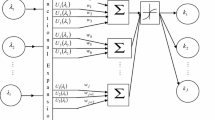Abstract
In this paper, the performance comparison of various types of functional link neural networks (FLNNs) has been done for the nonlinear system identification. The FLNNs being compared in the present study are: trigonometry FLNN, Legendre FLNN (LeFLNN), Chebyshev FLNN, power series FLNN (PSFLNN) and Hermite FLNN. The recursive weights adjustment equations are derived using the combination of Lyapunov stability criterion and dynamic back propagation algorithm. In the simulation study, a total of three nonlinear systems (both static and dynamic systems) are considered for testing and comparing the approximation ability and computational complexity of the above-mentioned FLNNs. From the simulation results, it is observed that the LeFLNN has given better approximation accuracy and PSFLNN offered least computational load as compared to the rest models.




















Similar content being viewed by others
Explore related subjects
Discover the latest articles, news and stories from top researchers in related subjects.References
Anders U, Korn O (1999) Model selection in neural networks. Neural Netw 12(2):309–323
Belli M, Conti M, Crippa P, Turchetti C (1999) Artificial neural networks as approximators of stochastic processes. Neural Netw 12(4–5):647–658
Cass R, Radl B (1996) Adaptive process optimization using functional-link networks and evolutionary optimization. IFAC Proc Vol 29(7):253–258
Castro JL, Mantas CJ, Benıtez J (2000) Neural networks with a continuous squashing function in the output are universal approximators. Neural Netw 13(6):561–563
Chen CP, LeClair SR, Pao Y-H (1998) An incremental adaptive implementation of functional-link processing for function approximation, time-series prediction, and system identification. Neurocomputing 18(1–3):11–31
Cui M, Liu H, Li Z, Tang Y, Guan X (2014) Identification of hammerstein model using functional link artificial neural network. Neurocomputing 142:419–428
Dash PK, Liew A, Satpathy HP (1999) A functional-link-neural network for short-term electric load forecasting. J Intell Fuzzy Syst 7(3):209–221
Emrani S, Salehizadeh SA, Dirafzoon A, Menhaj M (2010) Individual particle optimized functional link neural network for real time identification of nonlinear dynamic systems. In: 5th IEEE conference on industrial electronics and applications. IEEE, pp 35–40
Giles CL, Maxwell T (1987) Learning, invariance, and generalization in high-order neural networks. Appl Opt 26(23):4972–4978
Haring S, Kok JN et al (1995) Finding functional links for neural networks by evolutionary computation. In: BENELEARN1995, proceedings of the fifth Belgian–Dutch conference on machine learning, Brussels, Belgium, pp 71–78
Hassim YMM, Ghazali R (2013) Functional link neural network–artificial bee colony for time series temperature prediction. In: International conference on computational science and its applications. Springer, pp 427–437
Haykin S (1999) Neural networks: a comprehensive foundation. Prentice-Hall Inc, Upper Saddle River, pp 161–175
Hussain AJ, Liatsis P (2003) Recurrent pi-sigma networks for DPCM image coding. Neurocomputing 55(1–2):363–382
Kaita T, Tomita S, Yamanaka J (2002) On a higher-order neural network for distortion invariant pattern recognition. Pattern Recognit Lett 23(8):977–984
Lisboa PJ (2002) A review of evidence of health benefit from artificial neural networks in medical intervention. Neural Netw 15(1):11–39
Lu L, Yu Y, Yang X, Wu W (2019) Time delay chebyshev functional link artificial neural network. Neurocomputing 329:153–164
Majhi R, Panda G, Sahoo G (2009) Development and performance evaluation of flann based model for forecasting of stock markets. Expert Syst Appl 36(3):6800–6808
Naderpour H, Mirrashid M (2019) Classification of failure modes in ductile and non-ductile concrete joints. Eng Fail Anal 103:361–375
Naderpour H, Mirrashid M (2019) Moment capacity estimation of spirally reinforced concrete columns using ANFIS. Complex Intell Syst. https://doi.org/10.1007/s40747-019-00118-2
Naderpour H, Mirrashid M, Nagai K (2019) An innovative approach for bond strength modeling in FRP strip-to-concrete joints using adaptive neuro-fuzzy inference system. Eng Comput. https://doi.org/10.1007/s00366-019-00751-y
Narendra KS, Parthasarathy K (1990) Identification and control of dynamical systems using neural networks. IEEE Trans Neural Netw 1(1):4–27
Pao Y (1989) Adaptive pattern recognition and neural networks
Patra JC, Pal RN (1995) A functional link artificial neural network for adaptive channel equalization. Signal Process 43(2):181–195
Patra JC, Pal RN, Chatterji B, Panda G (1999) Identification of nonlinear dynamic systems using functional link artificial neural networks. IEEE Trans Syst Man Cybern Part b (Cybern) 29(2):254–262
Purwar S, Kar IN, Jha AN (2007) On-line system identification of complex systems using Chebyshev neural networks. Appl Soft Comput 7(1):364–372
Qi M, Zhang GP (2001) An investigation of model selection criteria for neural network time series forecasting. Eur J Oper Res 132(3):666–680
Setiono R, Thong JY (2004) An approach to generate rules from neural networks for regression problems. Eur J Oper Res 155(1):239–250
Shin Y, Ghosh J (1991) The pi-sigma network: an efficient higher-order neural network for pattern classification and function approximation. In: IJCNN-91-Seattle international joint conference on neural networks, vol 1. IEEE, pp 13–18
Shin Y, Ghosh J (1995) Ridge polynomial networks. IEEE Trans Neural Netw 6(3):610–622
Takagi T, Sugeno M (1993) Fuzzy identification of systems and its applications to modeling and control. In: Readings in fuzzy sets for intelligent systems. Elsevier, pp 387–403
Tawfik H, Liatsis P (1997) Prediction of non-linear time-series using higher-order neural networks. In: Proceeding IWSSIP 97
Teeter J, Chow M-Y (1998) Application of functional link neural network to hvac thermal dynamic system identification. IEEE Trans Ind Electron 45(1):170–176
Zhang GP (2000) Neural networks for classification: a survey. IEEE Trans Syst Man Cybern Part C (Appl Rev) 30(4):451–462
Zhou G, Zhou Y, Huang H, Tang Z (2019) Functional networks and applications: a survey. Neurocomputing 335:384–399
Acknowledgements
This study is not funded by any agency.
Author information
Authors and Affiliations
Corresponding author
Ethics declarations
Conflict of interest
The authors declare that they have no conflict of interest.
Human and animal rights
This article does not contain any studies with human participants or animals performed by any of the authors.
Additional information
Communicated by V. Loia.
Publisher's Note
Springer Nature remains neutral with regard to jurisdictional claims in published maps and institutional affiliations.
Rights and permissions
About this article
Cite this article
Kumar, R., Srivastava, S. & Mohindru, A. Lyapunov stability-Dynamic Back Propagation-based comparative study of different types of functional link neural networks for the identification of nonlinear systems. Soft Comput 24, 5463–5482 (2020). https://doi.org/10.1007/s00500-019-04496-0
Published:
Issue Date:
DOI: https://doi.org/10.1007/s00500-019-04496-0




